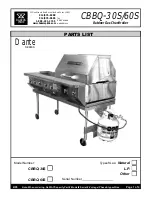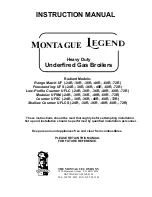
18-CG03D1-4
22
The vent connector pipe must not pass through a
combustible wall or partition unless adequate pro-
tection is provided at the passageway. An acceptable
passageway could be either an approved, ventilated
metal thimble which is at least 12 inches larger in
diameter than the vent connector pipe, or brick work
which is at least 8 inches thick constructed into the
wall and surrounding the vent connector pipe. (See
Fig. 17).
The vent connector pipe should extend only to (and
not beyond) the inside wall of the chimney (See Fig.
15).
Suggested method to improve chimney draft.
Figure 16
Figure
15
Proper insertion of the vent connector in chimney.
It is desirable to install the shortest vent connector
(also referred to as a fl ue or chimney connector) possi-
ble with the fewest number of fi ttings, i.e. transitions
and elbows.
Generally, 24 Ga. or heavier, single wall, lock seam-
type, galvanized steel vent pipe of the proper dia-
meter (see boiler general product specifi cations) and
fi ttings are satisfactory materials for the fabrication
of a vent connector. However, always consult local
codes and authorities for specifi c minimum require-
ments.
All horizontal sections of the vent connector must
slope upward not less than ¼ inch per foot from the
boiler to the chimney. Long horizontal sections of the
venting system must be supported at least every fi ve
(5) feet with metal straps to prevent sagging of the
vent piping.
Secure all joints in the vent connector with sheet
metal screws or equivalent fasteners.
A thimble should be used to connect the vent con-
nector pipe to the chimney so that the vent connector
pipe may be readily removed in case of inspection or
replacement.
In cases where the chimney extends to the basement
fl oor, the draft can usually be improved by fi lling the
base of the chimney with sand to within 12 inches of
the vent connector pipe after relocating the clean-out
door. (See Fig. 16).
All joints of the chimney must be tightly sealed. The
inside of the chimney should be free of any obstruc-
tions, such as loose brick, broken pieces of tile, or
corroded metal.
All chimney clean-out doors and fl ue connections
must fi t tightly so they will seal to avoid air leaks.
If chimney fl ues are divided or there are multiple
fl ues within one chimney, make sure there are no
openings in the partition separating the divided or
individual fl ues.
Figure 14
Proper chimney termination height for f
If the chimney penetrates a roof more than 10 feet
from a ridge, wall or parapet, a minimum of 3 feet
above roof or exit point must be maintained. See
Figure 13.
If the roof is fl at rather than the normal residential
Pitched roof, refer to Figure 14 for proper clearances.
















































